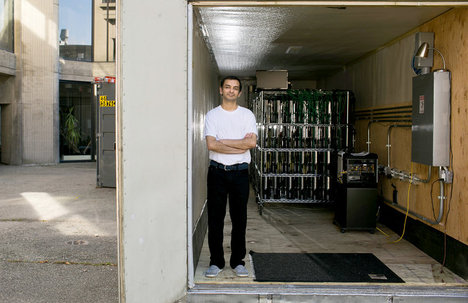 “Gaurav Khanna with a supercomputer he built at the University of Massachusetts Dartmouth physics department using 200 Playstation 3 consoles that are housed in a refrigerated shipping container.” Source of caption: print version of the NYT article quoted and cited below. Source of photo: online version of the NYT article quoted and cited below.
“Gaurav Khanna with a supercomputer he built at the University of Massachusetts Dartmouth physics department using 200 Playstation 3 consoles that are housed in a refrigerated shipping container.” Source of caption: print version of the NYT article quoted and cited below. Source of photo: online version of the NYT article quoted and cited below.
(p. D3) This spring, Gaurav Khanna noticed that the University of Massachusetts Dartmouth physics department was more crowded than usual. Why, he wondered, were so many students suddenly so interested in science?”
It wasn’t a thirst for knowledge, it turns out. News of Dr. Khanna’s success in building a supercomputer using only PlayStation 3 video game consoles had spread quickly; the students, a lot of them gamers, just wanted to gape at the sight of nearly 200 consoles stacked on one another.
. . .
Making a supercomputer requires a large number of processors — standard desktops, laptops or the like — and a way to network them. Dr. Khanna picked the PlayStation 3 for its viability and cost, currently, $250 to $300 in stores. Unlike other game consoles, the PlayStation 3 allows users to install a preferred operating system, making it attractive to programmers and developers. (The latest model, the PlayStation 4, does not have this feature.)
“Gaming had grown into a huge market,” Dr. Khanna said. “There’s a huge push for performance, meaning you can buy low-cost, high-performance hardware very easily. I could go out and buy 100 PlayStation 3 consoles at my neighborhood Best Buy, if I wanted.”
That is just what Dr. Khanna did, though on a smaller scale. Because the National Science Foundation, which funds much of Dr. Khanna’s research, might not have viewed the bulk buying of video game consoles as a responsible use of grant money, he reached out to Sony Computer Entertainment America, the company behind the PlayStation 3. Sony donated four consoles to the experiment; Dr. Khanna’s university paid for eight more, and Dr. Khanna bought another four. He then installed the Linux operating system on all 16 consoles, plugged them into the Internet and booted up the supercomputer.
Lior Burko, an associate professor of physics at Georgia Gwinnett College and a past collaborator with Dr. Khanna, praised the idea as an “ingenious” way to get the function of a supercomputer without the prohibitive expense.
“Dr. Khanna was able to combine his two fields of expertise, namely general relativity and computer science, to invent something new that allowed for not just a neat new machine, but also scientific progress that otherwise might have taken many more years to achieve,” Dr. Burko said.
. . .
His team linked the consoles, housing them in a refrigerated shipping container designed to carry milk. The resulting supercomputer, Dr. Khanna said, had the computational power of nearly 3,000 laptop or desktop processors, and cost only $75,000 to make — about a tenth the cost of a comparable supercomputer made using traditional parts.
For the full story, see:
LAURA PARKER “An Economical Way to Save Progress.” The New York Times (Tues., DEC. 23, 2014): D3.
(Note: ellipses added.)
(Note: the online version of the story has the date DEC. 22, 2014, and has the title “That Old PlayStation Can Aid Science.”)



